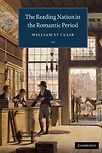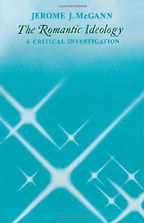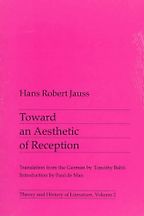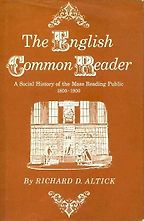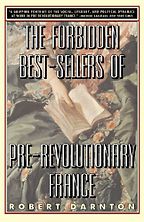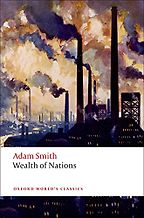Let’s start by talking about your groundbreaking book The Reading Nation in the Romantic Period, which suggests that ordinary people may not have been reading what we think they were in the 18th and 19th centuries. Can you give us a brief summary of your findings?
As I read the main books about Romantic literature, I was struck by the extent to which they tended to assume that the works which we most value nowadays were also those that were most valued in their own time. I began asking simple questions like “Who read Byron?” – questions that had seldom been addressed in the academic literature – and when the spadework was done, the answers turned out to be very different from the then received views, which were mainly derived from what past literary critics had written. I gradually began to build up a picture of which books were available to be read, in what quantities, at what prices and by what constituencies of readers, in the English-speaking world in the so-called Romantic period. These years – from around 1790 to 1830 – not only saw an astonishingly rapid expansion of reading, but political and economic upheaval, including the French and Industrial revolutions, and many other innovations in ways of thinking.
I was also struck by the extent to which literary studies took the form of analyses of literary texts without being concerned with effects. Although I am all in favour of literary criticism, and of picking out and celebrating the best writing, my reaction was that we cannot assess the effects of the literature of the past, or of other writings, without information from outside the texts themselves. I worked for most of my professional life in the British Treasury, where the most important questions were to do with the real world effects of public policies and how these effects could be assessed and evaluated. So if there was a link between printed literature and wider effects – if literature was indeed as influential as is usually assumed – I thought it ought to be findable.
My book involved searching for primary records in archives of publishers, printers, libraries, trade catalogues and auction sales of copyrights, in several countries. To my surprise they turned out to be astonishingly full, and arranging and summarising the information takes up a large part of the book. What I was trying to apply, and to get over to my readers – and it hasn’t been accepted as fully as I might have wished – is that the conclusions of my book arise from the data. I’m not putting forward arguments and backing them up with footnotes – I’m trying to apply the scientific paradigm of collecting all the relevant data, searching for emerging patterns, putting forward findings and new hypotheses and allowing and encouraging other people to see if they can replicate the results.
Can you tell us more about the conclusions that you reach? I know that one of the notions you question is that the 19th century was the “golden age of Wordsworth”, as the hard data showed that not to be the case.
The “age of Wordsworth” convention is a good example. The way literary history has been presented has been as a parade of the literary figures who are regarded as great now. Wordsworth is one. Blake, Shelley and Keats are others. But in their time these four authors were little read. Compared with Scott and Byron, the numbers are tiny. What also comes out strongly is that people didn’t just read the books first published in their times. In fact, most of the books being read in the Romantic period were written at least a generation or two before, and cannot by any stretch be regarded as romantic. And this mismatch comes to the fore when you try to look at the mentalities that might be expected as the result of the actual reading. Many people in the Romantic period are stuck in a pre-Enlightenment, pre-modern view of the world – a largely static, local, rural, and religious culture of English villages – even though their lives had been transformed by urbanisation, industrialisation, wars and empire. The trajectory of reading is very different from the trajectory of writing. That’s a general finding, not just one specific to the Romantic period, and one that suggests that any attempts to relate writing to the effects of writing needs to take account of the time lags.
What people read in this period had a lot to do with accessibility of books, didn’t it? Pricing was key. Wordsworth wasn’t prepared to sell his work cheaply and therefore wasn’t as widely read as he could have been. Is that correct?
Yes, that is correct. Wordsworth’s books were mostly expensive and the numbers of copies sold was small. It took years to sell out an edition of 500 copies even with remaindering. The Excursion was one of the most expensive books for its size ever published. The retail price was equivalent to two or three weeks’ wages for a skilled manual worker. For the price of a single copy of The Excursion, when it was first published, you could buy more than 100 fat pigs. So Wordsworth’s works don’t really reach a middle class, let alone a mass readership until they came out of copyright towards the end of the 19th century. A lot of my book is about the book industry – the technology, the pricing and the copyright regimes that determine price. At first I only did that economic analysis as a way of getting at who had access to which texts at which time, a precondition for getting at potential effects. But strong patterns come out from that analysis of the book industry – notably the direct link between the changing copyright regime and price, and therefore access. Attempts to assess the effects of writings from a purely cultural point of view, without bringing in the conditions in which they were published, priced and circulated in material form are, in my view, methodologically incomplete. In the Romantic period, apart from word of mouth, ink on paper was the only way in which complex ideas could make their way across time and distance.
Let’s turn to your first book, The Romantic Ideology, which calls for a radically revisionary reading of Romanticism. Please tell us more.
I’ve chosen this book because, along with other essays by Jerome McGann, it does explain and consider what Romanticism is, and how it continued to influence our ways of thinking. Romanticism can be regarded as beginning as a movement in the later 18th century in Germany and going on until the mid-Victorian period. It has a number of components that don’t necessarily cohere. One is the rhetoric of individual genius, inspiration and creativity that takes it as given that the greatest authors and artists are able to declare truths that transcend their own times. Another is an emphasis on individual feeling that can be seen as a reaction to the mechanistic view of human nature that you get in the philosophical writings of the Enlightenment in the 18th century. A third was that individuals can learn timeless truths direct from looking at “nature”, such as the mountains and the forests, conceived of as unchanging and benevolent, without the hard grind of study and education. When, for example, Wordsworth claims that “One impulse from a vernal wood May teach you more of man, Of moral evil and of good, Than all the sages can”, we can surely now see that this is nonsense. It is not a perennial truth but a way of thinking common in Wordsworth’s day and earlier, but now of only historical interest – it is an error that has been superseded.
What McGann says is that literary studies, and studies of Romanticism in particular, were prisoners of the phenomenon that they were allegedly studying. Such studies commonly talked about individual genius and about the meaning of the text as if that was fixed. They operated in a tradition of hermeneutics, which came from bible studies, that regards literary works as containing hidden truths that can be teased out by careful armchair study. Editors searched for the final intentions of the author as being the best guide to his best thought. In fact, as emerges from many empirical studies of how Romantic works actually came into being in the form that they did, many people besides the authors normally participated in the composition, production, presentation and dissemination, and printed texts were seldom stable. And besides being socially produced, they were also socially consumed, not only by being read aloud and talked about in drawing rooms and reading clubs, but by having been composed with the known preferences of readerships anticipated in the actual writing.
I chose McGann because he rightly says we shouldn’t uncritically swallow Romanticism but should unpick its assumptions and study literature, and the effects of literature, just as we should study other phenomena, by standing outside and not inside the rhetorics.
In that sense, your book is very much outside.
My book is very much outside the rhetorics of Romanticism. A lot of books nowadays claim to stand outside these rhetorics. There is nothing wrong with studying and celebrating the great authors, even when we cannot accept their worldview, and I am not advocating cultural relativism. Where the confusing error occurred was in thinking that studying the great authors in the “canon” takes us somehow to what actually happened in the past, or to the ways of thinking prevalent in the past.
There is also another point I would like to make. We have a spate of books now which I call “in the imagination” books, where the author, rightly distrustful of taking the great canonical authors as representative of an age, makes his or her anthology of non-canonical texts. So a scholar might bring together a piece of political writing, a play, a long-forgotten novel written by a woman and a book of advice on children’s education, that were all produced at much the same time, and the author then makes remarks about them and the “imagination” of the society from which they emanated. This kind of study is, frankly, quite easy to do in the age of on-line texts, but I’m very sceptical about the methodology or the general usefulness of what they can tell us, given that there is an infinitude of texts from which such anthologies can be compiled and an infinitude of criteria for making the selections. What claim can such texts have to represent the “imagination” of an age? These studies appear to me to be a residue of the romantic notion that texts deserve to be scrutinised without paying regard to the material conditions under which they were produced and read, or the many alternative texts that their readers, if there were any, had access to, and may have been influenced by.
Next you’ve chosen to put two texts together – Hans Robert Jauss’s Toward an Aesthetic of Reception and Prospecting by Wolfgang Iser. Why?
I put them together because Jauss and Iser worked at the same university and led a movement – the Konstanz school. They both tried to theorise the role of the reader. They too were very uncomfortable – as McGann was – with the notion that meaning just inheres in texts and it’s the role of the professor to tell people what the text means. So they theorised what goes on in the act of reading. The reader, they said, is not a passive recipient of meanings on the page, but brings his or her own experience and ideas to the act of reading and to the making of meaning.
Jauss is the one who invented the notion of “horizons of expectations”, which is an attempt to say what the reader already has in his or her mind before he or she encounters the literary text. I use “horizons of expectations” a lot in my book. Although the notion is a theoretical concept, I tried to apply it empirically with actual historic data and I found it works well. For example, we can appreciate how astonishingly liberating was the experience to the early readers of the radical works of Byron and Shelley – which, owing to a quirk in the copyright law, were sold at an extremely cheap price in huge numbers – when we understand that their previous reading, if they had had any at all, was texts of the rural religious culture of the previous century, which is all they would have been given at school and which presented an England that was as far from their experience as Virgil’s Georgics. We have here an example in which we can trace in detail, with quantification, the whole literary process from the writing of highly innovative works, through publication and sales, to readerships, and on to the establishing of a reforming movement which brought about real world effects.
Is this reception theory?
It is reception theory, and in my case, also practice. The theory aims to emancipate the reader, giving her or him the active role that we know from our own experience occurs. Reading is an event, a transaction. This does not mean that anything goes, and that there is no role for the critic in helping readers to understand how the author has achieved his literary effect, with allusions, historical context and so on. But it is possible to read without being convinced, even to read actively against the grain, to pick and choose which passages to give weight to. In particular, the reader normally has a good idea of what to expect before he or she starts – for example, what genre the book belongs to. With romantic fiction, modern bookshops arrange their shelves to alert buyers to exactly what to expect. For example, repeating the old familiar themes of happy endings, marriage, the rake reformed by the love of a good woman, and so on, as well as new genres which are constantly being added. That prefiguring, often through the external design of the book, also happened in the Romantic period, and it is condescending to the readers as well as unhistorical to think that they were not aware of what was going on and complicit.
OK, let’s move on to Iser now.
Iser, whom I knew quite well before he died a few years ago, was very much driven by the experience of Germany. He had grown up as a young man in the ruins of Germany and saw that the authoritarian way of teaching literature – that the professor knows what is right and the pupil writes it down and reproduces it – failed to encourage critical engagement and had been part of the explanation for why Germany had suffered such disasters. He tried all his life to devise a theory of reception which preserved the notion of value in high culture. So both he and Jauss talk about “aesthetic” but I think in English we would say “value”. Iser was not saying that all texts are of equal value – that Jeffrey Archer is as good as Shakespeare – but tried to find a theory that both gave an active role to the critically alert reader and preserved notions of cultural value. Personally, I don’t think he succeeded but he was trying hard until the last months of his life. But also, I don’t think we need to do that. I think we can separate the question of identifying and conferring value on some texts from the question I address in my book – how are mentalities formed by the reading of the past?
What were the schools of thinking that Iser was opposed to?
The opposition is very much associated in the anglophone world with the English literary critic FR Leavis and an insistence that there is a canon of great works – Shakespeare, Milton, Wordsworth, Dickens and so on – and that this is the “great tradition” and it’s the role of an elite professoriate to preserve and defend it, and pass it on to the next generation. But that doesn’t give any role to the reader.
As an interpreter?
Yes, as an interpreter. That approach, besides being authoritarian, underestimates the active role of the reader in the making of meaning, as the Konstanz school saw. And it is of no help in addressing the questions I am more interested in, such as: How did books and reading help to shape mentalities? Why and how do societies change? What are the historical processes – that must involve the competition between ideas being carried in material form – that have brought us, as societies, to our present mental states?
Tell us about your third choice, The English Common Reader: A Social History of the Mass Reading Public, 1800-1900 by Richard Altick, which is often cited as a foundation text for scholars studying the history of the book.
It’s an astonishing book, published in 1957. Altick is so different from what came before because he wants to find out what was actually available to be read in the 19th century. He has lists of sales figures and best sellers, and books produced for the poor. He’s very much a direct predecessor of what I tried to do.
Because he lived in the United States and did his work in the immediate post-war period, all his information comes from printed books. So he would go through autobiographies of Victorian authors and pick out what they said about the number of copies they sold. He didn’t have the opportunity to do any kind of formal archival work among publishers’ records, and didn’t have much sense of the book industry being an economic system. Nor did he have any general economic theory to apply to the information that he collected and provided.
The book is so sparkling and so full of information that it’s been treated as the standard book since it was first written. But no scholars came forward and said this was a terrific book and let’s add to it, let’s compile proper factual information based on sales and production from archives and from the other sources Altick didn’t have the opportunity to look at, but we have. The result is that students are still relying on the pioneering work of Altick more than half a century later.
What conclusions does the book draw about what people read in the 1800s? Did it challenge conventional wisdom?
I think it did challenge conventional wisdom. One of the books of the 1930s was by the English literary critic QD Leavis, wife of FR Leavis, called Fiction and the Reading Public, in which she gives a potted history of an imagined readership, the “general reader”, who read novels in the 18th and 19th centuries. What distinguished Altick from QD Leavis was that Altick actually had some numbers, albeit scattered, and was interested not just in the tiny, leisured elite who had the time and money to read new books as they came out. But the main point I would make about Altick is that his challenge to what literary studies could be, and their potential contribution to answering bigger questions about the way culture is formed, was not taken up until recently.
It’s interesting hearing you talking about methodology when it comes to looking at what was read in the past. You come from a Treasury background and search for the hard data, while others opt for a less rigorous and more subjective approach. There is quite a tension between these two approaches.
In the Treasury, the last thing you wanted your work described as was “anecdotal” – it was always a put-down. Anecdotal evidence is something that you turn to when you haven’t been able to find a more formal, actively searched for and preferably quantified kind of evidence. It’s very much a last resort. This is because it is difficult to know how far an anecdote can be trusted, how far a story is representative of something more general, and how far it is just a pleasing story that people like hearing. I tried in my book to get beyond the collection of anecdotes and strive for completeness of availability, at least of material books, noting the many gaps. That does not, of course, take us to reading, or the results of reading, but is, I would say, an indispensable step, before tackling the more difficult questions. And these more difficult questions are still present, even if shied away from, in all studies that do not look beyond the text.
Moving on to your next choice, The Forbidden Best-Sellers of Pre-Revolutionary France by Robert Darnton, did books help ferment the revolutionary atmosphere in France?
The French Revolution was driven by ideas, and once you start trying to trace ideas you have to consider the print in which ideas were carried. As a young man, Darnton discovered in Switzerland the archive of an offshore publishing firm that smuggled books into France before the French Revolution. It had all the records about the paper, the production, even on the mules that carried banned books across the Alps.
Darnton is interested not just in publishing history, but in trying to get at effects. Before Darnton, a favourite historical question might be: What were the causes of the French Revolution? People could write about the oppression of the peasantry and so on and that’s valuable history. But a more precise question is: Why, when the revolution started, did so few came out in support of the ancien regime? The question then becomes something to do with the minds of the people and the fact that legitimacy had been lost. And that might lead you to suggest that the reason that many groups didn’t support the monarchical-ecclesiastical state was because they had been reading Voltaire and Rousseau and came to the conclusion that it all was a magnificent tissue of bluff that no reasonable person could assent to. But then Darnton asks: Where then are the books of Voltaire and Rousseau that we should be finding in France? And, in fact, there aren’t that many. Instead, what he finds are huge amounts of books which are now forgotten, many of which were pornographic and libellous of the royal family.
I believe a book on the private life of Louis XV was particularly popular.
That’s right. They make an extraordinary genre. Some are mainly descriptions of sex, without pretence of emotion, let alone of romantic love, and then the characters pause for a minute and discuss the philosophical principles of government, before going back to the pornography. It was, at least in part, these banned books that helped to undermine the legitimacy of the regime and that the regime was too proud to defend itself against.
You touched on the censorship that existed in France. In Britain, would it be right to say the censorship came from an informal alliance between the state and the big publishing houses that kept certain titles off the shelves?
That’s right. The book industry in 18th century France, as in England, was a cartel – an association of producers that combined to keep prices artificially high by restricting supply. The book industry, in alliance with the state, practised a high degree of self-censorship, which is much more effective than censorship. As Darnton has written elsewhere, using examples from India and modern Germany as well as France, attempts to ban particular works by some kind of individual licensing has historically been less effective, from the point of view of the governments and churches and others who have feared the power of reading, than vague general laws that put the onus for conforming on the author, publisher, printer and bookseller.
What does Adam Smith’s magnum opus The Wealth of Nations tell us about the history of reading?
It’s a long book and it covers many things. But it’s particularly important for the history of reading. Smith thinks in terms of systems. There is an economic system, a financial system, an agricultural system and so on. He’s modern in that way, but he also looks at business practices. He offers data for the reader to consider and scrutinise. He does not argue as an ideologue. One of the systems that he looked at is monopoly and competition. There’s a terrific passage about the silversmiths and the guilds in various towns that were given exclusive rights to sell silver and control the prices and training of silversmiths. He shows that, contrary to what was claimed, this system led there to being less silver in the country than there would be if anybody was allowed to work in silver. So he’s saying the wealth of the nation is reduced by monopolistic structures that are publicly presented as increasing it. Smith says much the same about the monopoly of copyright and argues that, like any other monopoly, it should only be tolerated for a short time in order to encourage innovation that is of general usefulness to the society that gives the privilege.
So was he an advocate of reducing the length of the copyright publishers held?
Until 1774 copyright was perpetual in England, although only 28 years maximum in Scotland. The eventual 1774 decision by the House of Lords to stop the book industry from unlawfully exercising perpetual copyright, that had been battled over for half a century, was greatly influenced by Smith’s lectures, which attracted much attention before his book was published. The Romantic period, when there was a short copyright, coincided with an amazingly rich episode in the writing not only of literature but in history and political economy, and with a huge increase in reading generally, as the prices of out-of-copyright books tumbled. Since then, the copyright term has gradually been lengthened and the situation now is that it’s nearly perpetual. So the link between the granting of a short-term monopoly to provide encouragement to innovation for the benefit of society as a whole has been lost. And the issues of freedom and access that confronted the 18th century and the Romantic period now have to be faced again in the age of the Internet.
April 30, 2012. Updated: May 3, 2025
Five Books aims to keep its book recommendations and interviews up to date. If you are the interviewee and would like to update your choice of books (or even just what you say about them) please email us at [email protected]
Five Books interviews are expensive to produce. If you've enjoyed this interview, please support us by donating a small amount.

